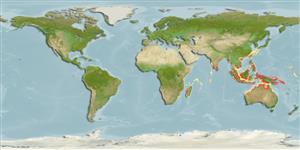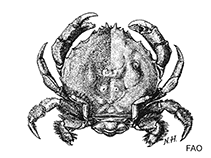Lauridromia indica (Gray, 1831)
Cannonball sponge crab| Native range | All suitable habitat | Point map | Year 2050 |

|
| This map was computer-generated and has not yet been reviewed. |
| Lauridromia indica AquaMaps Data sources: GBIF OBIS |
Envoyez vos Photos
Images Google | No image available for this species;
drawing shows typical species in Dromiidae.
Images Google | No image available for this species;
drawing shows typical species in Dromiidae.
Classification / Names Common names | Synonyms | CoL | ITIS | WoRMS
| Decapoda | Dromiidae
Environment: milieu / climate zone / depth range / distribution range Écologie
; profondeur 7 - 90 m (Ref. 3175). Tropical
Distribution Pays | Zones FAO | Écosystèmes | Occurrences | Introductions
Indo-West Pacific.
Length at first maturity / Taille / Poids / Âge
Maturity: Lm ? range ? - ? cm Max length : 8.3 cm CW mâle / non sexé; (Ref. 343); 7 cm CW (female)
Description synthétique Morphologie
Carapace rounded, much wider than long; surface convex, with dense pubescence; 6 anterolateral teeth. Spine present on outer margin of dactylus of last walking leg. Light brown with bright pink fingers.
Maximum size of male from Ref. 3175. Omnivorous, feeds on sea stars (Asteroidea). Carries sponges and colonial tunicates on back for camouflage (Ref. 343).
Life cycle and mating behavior Maturité | Reproduction | Frai | Œufs | Fécondité | Larves
Members of the order Decapoda are mostly gonochoric. Mating behavior: Precopulatory courtship ritual is common (through olfactory and tactile cues); usually indirect sperm transfer.
Référence principale
Références | Coordinateur | Collaborateurs
Ng, P.K.L. 1998. (Ref. 343)
Statut dans la liste rouge de l'IUCN (Ref. 130435)
statut CITES (Ref. 108899)
Not Evaluated
CMS (Ref. 116361)
Not Evaluated
Menace pour l'homme
Harmless
Utilisations par l'homme
Pêcheries: intérêt commercial mineur
| FishSource |
Outils
Plus d'informations
Pays
Zones FAO
Écosystèmes
Occurrences
Introductions
Stocks
Écologie
Régime alimentaire
Éléments du régime alimentaire
Zones FAO
Écosystèmes
Occurrences
Introductions
Stocks
Écologie
Régime alimentaire
Éléments du régime alimentaire
Sources Internet
BHL | BOLD Systems | CISTI | DiscoverLife | FAO(Publication : search) | Fishipedia | GenBank (genome, nucleotide) | GloBI | Gomexsi | Google Books | Google Scholar | Google | PubMed | Arbre de Vie | Wikipedia (Go, chercher) | Zoological Record
Estimates based on models
Preferred temperature
(Ref. 115969): 26.1 - 29.1, mean 28.2 (based on 1406 cells).
Catégorie de prix
(Ref. 80766):
Unknown.



